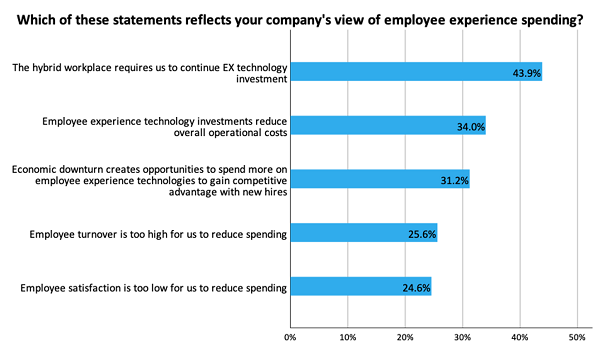If improving employee experience is your jam, then you’ll find some heartening news coming out of the global tech spending research study Metrigy conducted last month with 400 end-user organizations. Unfortunately, you’ll also be disheartened by one of the findings.
Let’s start with the good stuff.
Spending on employee experience technology, though flat for most participating companies (63.1%) through the remainder of 2022, looks strong for 2023. More than 53% of companies plan on increasing their investments in employee experience technology next year, on average by nearly 24%. Even the flat spending, taken in context of what’s been happening until now, isn’t much to fret over. Companies have placed employee experience optimization front and center during the pandemic.
As we found in our Employee Experience & Workforce Engagement 2022-23 research study, 52.3% of the 250 participating end-user organizations revised their employee experience strategies due to the changing workplace dynamics of the last two years. Another 26.6% have launched programs from scratch. Technology adoption has followed suit, with 77.6% of companies already using or planning to adopt employee experience apps, tools, or platforms in 2022. You could reasonably argue that many companies have done the big spend on employee experience technology for 2022 and now are looking at incremental spending in 2023. Plus, we mustn’t overlook the 26.6% of companies in the tech spending study planning to increase their employee experience spend through year’s end.
Not surprisingly, hybrid work—the changing workplace dynamic that required a rethink on employee experience strategy—is the top driver for increased spending. In the tech spending study, 43.9% of companies said the hybrid work model requires continued investment in employee experience technology. Roughly a quarter of companies said employee turnover is still too high and employee satisfaction too low to reduce spending. And, for 31.2%, the economic downturn creates opportunities to spend more on employee experience technologies so they can gain competitive advantage with new hires.
Collaborative goal-setting apps will be one hot product area for 2023, based on the percentage of companies increasing spend and the percentage increase of that spend. These apps allow for company-wide management of Objectives & Key Results (OKRs), integrated with information and data from customer relationship management and other corporate apps. They can help bolster employee experience by making employees feel fully invested in the company’s success, rather than cogs in the big corporate wheel. Twenty seven percent of companies will increase spending on collaborative goal setting for 2023, just barely behind the 27.3% of companies planning to spend more on employee experience management platforms. Spending will increase by 23.4% for this type of app in 2023.
But here’s the kicker. When asked which of eight technology areas they would cut spending on if forced to by the economy, Metrigy’s study participants placed employee experience at the top of the list... ahead of professional services, peripherals, laptops/computers, workplace collaboration, customer engagement/customer service, security, and WAN/network. Ouch. And if that’s not bad enough, HR is among the business units that can expect to see decreased spending in 2023. It’s in the top three for decreased spend, for 12.6% of respondents, behind commercial real-estate (15.8%) and at the same level as sales.
Let’s hope that’s a big “if.” Surely a de-emphasis on employee experience through spending cuts on technology and HR personnel will set companies on a backward course in navigating the hybrid workplace.




